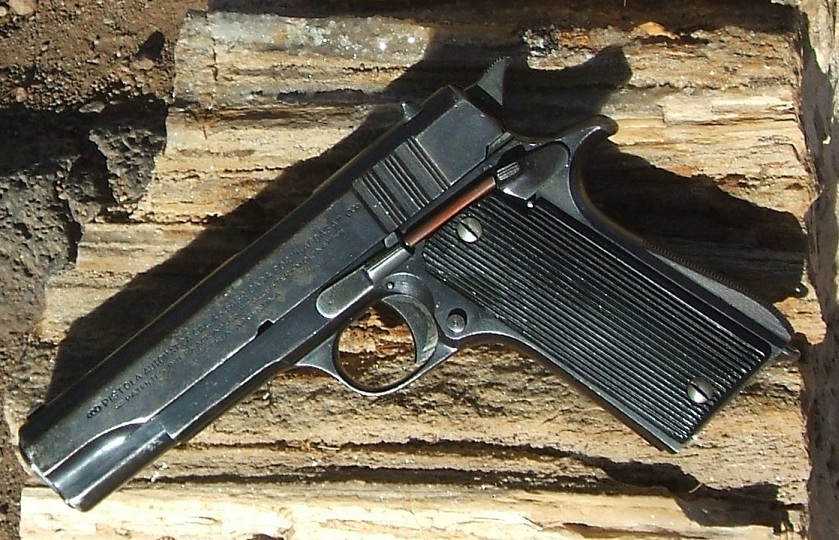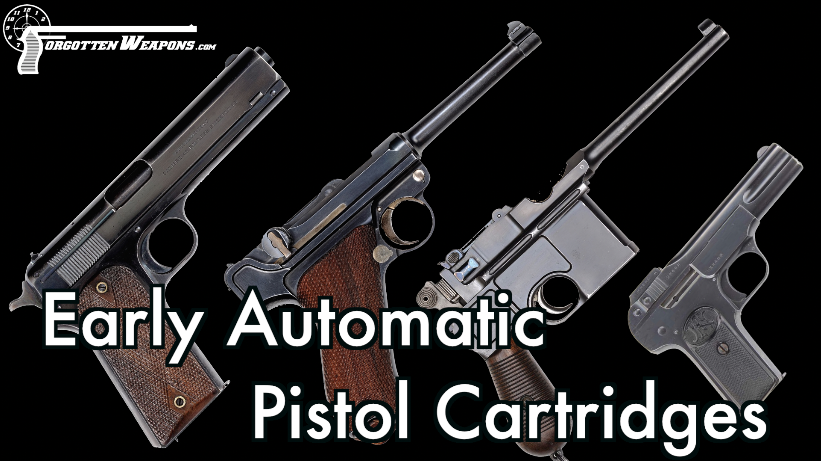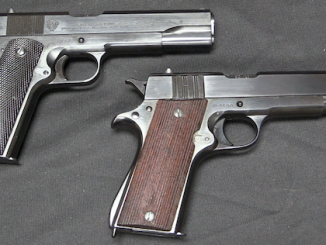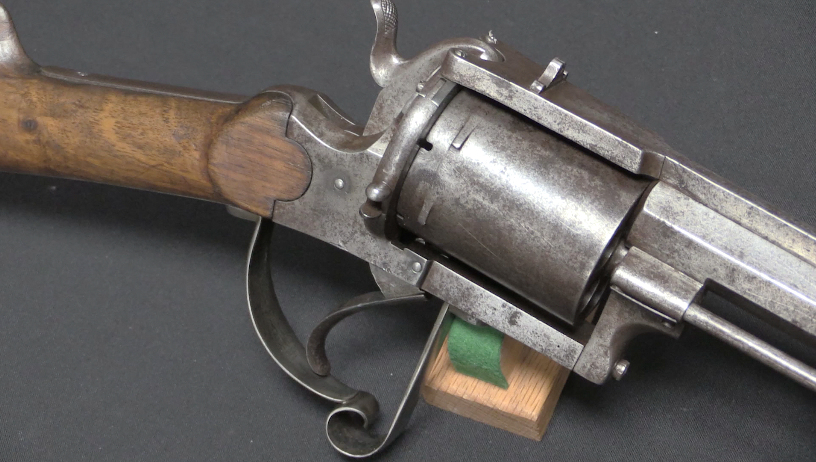I recently picked up a new carry pistol…it’s about 65 years old, rattles a bit when you shake it, has a bit of pitting on the slide, and the finish is worn off all the corner and edges. I think it’s a great carry piece. It’s an Argentine Ballester-Molina, surplussed from Argentina Navy service and it cost me all of $300. I have a pile of handguns to choose from, so one might wonder why I would choose something with so many perceived negative characteristics…
Let me say first off that I am not – and don’t pretend to be – a commando, mall ninja, “sheepdog”, “operator”, or Charles Bronson. I have taken some professional firearms training and spent several years having my ass handed to me in bullseye competition, but there are scads of people out there who are faster and better than me with a gun. So the notions I’m about to lay out should be taken with a big grain of salt.
One thing I have gained from having spent time handling and examining lots of old and obscure firearms is that arms technology really hasn’t changed much in the past half century or more. Materials science has made some big advances, but the mechanical designs of pistols really hasn’t. Most of the common handguns being manufactured today are still using a Browning-style tilting barrel locking into a steel slide. They use double-stack magazines now (1930s tech), and often polymer frames (1950s tech) and strikers instead of external hammers (pre-1900 tech), but at the same core design. So as I look for a carry gun, I’m not prejudiced against models older than my parents.
Also, I like the idea of carrying a pistol made for military service. Most of the time, military testing does a good job of weeding out poor designs and finding guns that will function reliably in pretty adverse conditions. Especially when you find a period where a nation was upgrading its arms during peacetime, the chances are pretty good that the new guns will be good ones. That is the case with my Ballester-Molina, which was manufactured in about 1946.
I have always found the 1911 pistol to fit my hand and point very well for me, and the Ballester-Molina retains that same basic profile of the 1911 with some improvements. It does not have a grip safety (which I think is an unnecessary complication), and does have a very effective beavertail that actually prevents the hammer from biting (unlike the lousy stock 1911 beavertail).
The Ballester-Molina, like most 1911-style pistols, has a single-action trigger and manual safety. This system has generally lost favor in today’s world to mechanism like the Glock’s. The longer trigger pull of those guns has prevented countless ill-trained police officers from shooting themselves in the thigh as they reholster, but I would like to think that I am conscientious enough to not need that assistance. I prefer the short, crisp break of a good single-action trigger. I think it even makes up for the small military-style sights on my Ballester. Given the choice, I would rather have small sights and a good trigger than a poor trigger and great big sights.
Lastly, the rattle. I think a lot of people would immediately reject a pistol that rattled, but to me it says that there is clearance between the slide and frame and the gun will continue to run when it gets dirt, lint, powder residue, Cheeto crumbs, and anything else in it. The 1911 is an inherently less accurate design, with the barrel bouncing around inside the slide. If you tighten up all the clearances to the ten-thousandth of an inch to get really excellent groups (or just on the theory that money put into a gun must somehow mean it becomes better), you also cripple its ability to run in adverse conditions by allowing a single little piece of grit to lock up the slide/frame movement. Yes, I want a gun that will shoot to point of aim and maintain reasonable groups – but I’ll leave the match gun in the safe when I’m picking a pistol that I may have to depend on.
Ultimately, the outcome of a dangerous incident will depend mostly on your mindset and skills, not the particular hardware you’re carrying. So why not take the road less traveled and add some flavor to your daily carry?





Great choice! My first carry gun was a Colt-made Argentine Model 1927 and it served me well for over 10 years in a genuinely evil Detroit neighborhood.
A couple of technical points on reviving these ‘old soldiers’:
Pre 1946 western hemisphere spring steel had high phosphorous content and gun springs made before 1946 need to be replaced to provide proper functioning and prevent the gun from damaging itself. The high phosphorous springs have a tendency to ‘set’ under sustained load (shorten in the case of coils, bend in the case of leafs) and no longer provide their design forces.
Dust and lint are your worst problem in a handgun carried on a daily basis. Get into the habit of stripping and air blasting your carry gun on a monthly basis.
Rust is your second worst problem in a carbon steel handgun carried on a daily basis. The wax based Mil-PRF-16173E, Grade 2 rust inhibitors are the very best protection I have found. The most common commercial products which meet this specification are ‘LPS3’ and ‘Tectyl 846’. In the USA these can be purchased from most industrial supply companies. The thin waxy film these inhibitors leave on a surface will protect raw steel from corrosion for 2 years in outdoor exposure!
What sort of groups does the rattlin’ Ballester-Molina give for the trade off of less worry about lint and dust?
Another vote here for an Argentine lady, for me a Sistema Colt 1927. I bought three when they popped up in a C&R circular a few years back, and I love the one that’s been refinished and had new springs put in. She goes bang every time I pull the trigger, and gives me a love-bite every single time. Blissful 🙂
Too heavy, I’ll stick with my little J-frame Smith….
That’s why I carry a CZ-82. Albeit not as old as the Ballester-Molina but it’s hard to beat the reliability of a direct blowback. I would love to carry one of those old striker-fired pistols though.
I love my CZ-82. Certainly doesn’t hit as hard as a .45 ACP, but if an attacker doesn’t go down after 12 rounds of 9mm Mak hollowpoints, it probably isn’t human. And getting 12 shots in a pistol that small and easy to conceal is hard to argue against.
The “Ballerina-Molester” is a good and dirt simple choice…it’s not a ‘complicated’ as the 1911 design, but it launches the 230 grn Ball .45 ACP round – any hit (preferrably TWO)somewhere between the pubes and the cranium is a fight stopper…I have a Colt ACE copy made in Argentina on a Modelo 1927 frame and slide, marked “Policia de la Provincia de Buenos Aires” on the RHS of the slide and D.G.F.M.(F.M.A.P.) on the LHS…it was imported in the mid 90s for a very short time. Bought mine from a dealer here in S FL. IIRC it was $350…haven’t seen one ANYWHERE since….Talk about a “Forgotten Weapon”!!!
CB in FL…once plentiful and inexpensive the BM is now relatively rare and expensive (compared to earlier times)
Great choice! My carry choice is a Star Model BM considered “modern” in the late 50s early 60s. Got it for around 300 bucks too. No grip safety. It does have a magazine safety I am not a big fan of, but I can live with it. I like the all steel construction, blue finish is still in decent shape. Best of all it is sized just right for the cartridge, 9mm and it also fits my wife and daughters hand quite well. Groups run 2-3 inches depending if I am taking my time or in a hurry. If I am in a dump all the rounds now kind of hurry it will keep all shots nicely centered on a human torso type target.
That is some of sanest writing out there on carry guns..
The late Chuck Karwan once mentioned that he considered building a custom Ballester-Molina: better sights, extended safety, and match barrel. The barrel would have been easy as it interchanged with the M1911, as do the magazines.
I shot my first two years or so of USPSA competition with an Argentine 1927. I still have a scar on my right hand from the hammer bite. Did some mild custom work to it before I got rid of it (sights and a beaver-tail).
You might try Boeshield T9 as a rust inhibitor – Developed by Boeing, it also leaves a thin waxy film on surfaces – I use it here in FL on my firearms and knives.
CB in FL
Love your choice and reasoning! Being a wheelgun kinda guy I like my Webleys though.
Very nice gun – I’ve got a British contract Ballester-Molina and it’s a great shooter.
When it comes to mil surp carry pieces I like the FEG pa63 I picked up a few days ago. It just feels good in my hand though i have to admit the new hasnt worn off yet so i may be a bit biased. Also Charles Bronson? Ian you are showing your age with that one.
Marginally off topic (but still about Latin takes on Browning style Autos)
Wilhelm Gary, in his design for the late 70s / early 80s Llama Omni, worked out a way of grinding two rings at a slight angle to each other on the muzzle end of the barrel, allowing a tight fit in the bushing, without having it bind as the barrel tilted to unlock.
The EPO document at the head of the list, describes the process best http://worldwide.espacenet.com/searchResults?compact=false&ST=advanced&IN=gary&locale=en_EP&DB=EPODOC&PA=gabilondo
FWIW: The designer’s name was Gary Wilhelm. He was a former High Standard employee.
Thanks
I wasn’t sure which way around his name was supposed to go.
I’ve stumbled onto a couple of his patents for High Standard.
Do you know if he’s still alive and active as a designer?
I remember seeing adverts for the Omni when I was in my teens, and it appeared to be a very high quality gun, but it was always far too expensive for me to afford (when it was still legal to own pistols in Britain 🙁 ).
Given the span of his career, I suspect Mr. Wilhelm has either retired or passed on.
The Omni was interesting, but I remember that the frame and stocks were quite thick. The .45 used standard M1911 magazines, while the 9mm magazine had a weird profile reminiscent of the later HK P7M13.
“Given the choice, I would rather have small sights and a good trigger than a poor trigger and great big sights.”
Terrible statement.
What does this weapon do for you that a G19 doesn’t?
It fits my hand better, has a better trigger, and conceals more easily on my person. Sights vs trigger is very much a personal choice, IMO.
Another reason for using an inexpensive but reliable gun, is that if you ever use it, and the police get involved, you won’t get it back for a year, or after the trial. Cops once took an $1100 Kimber from me, and I didn’t get it back until after I heard “not guilty” in court a year later!
One thing to consider about surplus designs is that some are not drop safe. The 2009 death of gunwriter Steve Malloy was blamed upon his Colt M1903 Pocket Hammerless discharging after it hit the floor.
I can dig it.
I have a Mauser HSc in .32 ACP that was made in 1942 & is civilian proofed – fairly rare by April of 42. It got brought back to the US after the war, presumably by a GI, and got badly nickel plated destroying any collectors value. The nickle is chipped and peeling and ugly as all get out. But the thing shoots like it was new and is the most accurate pocket pistol I’ve ever owned. I carry it as my CCW quite happily. I may get it refinished. Perhaps one of those Neon Blue Cerakote (sp?) jobs 👿
A reasonable choice.
In fact Grip Safety on Colt 1911 is realy needless since, does not lock the sear but
only blocks the trigger bar movement.
J.M. Browning had used the Grip Safeties on a few of his ingenious pistol designs
that best of which was on FN Model 1903, since not only blocking the sear movement,
but permitting the slide backward traction with a loose hand when the pistol being
on “Uncocked” mode. FN 1906, 1910 and 1922 had also positive sear blocking grip
safeties without cocking feature of Model 1903, and worst use of this safety form
was on Colt 1911.
A Ballerina-Molester? Really? 😉
In the 70s and 80s, part of practical smithing on a 1911 for carry was to pin the grip safety so it could still be used in weak/wounded hand. That was a fashion that has fallen out of favor (I’ve been on ranges that would not allow these guns because they had “defeated safety systems.” Stupid, as the grip safety was something the Army required for Cavalry use, not something JMB thought was an awesome idea.
The Ballester Molina and the 1927 Sistema Colt are both quite good. Sarco has some of each… the quality grades basically depend on how well the roll marks are legible. None of them have any quantity of original finish. (Not seen with my own eyes but I sent a PA-based friend there to see, and he phoned me from his car on the way home to gloat about his new ’27.
The “refinished” ones are painted — “slathered in black glop” per the same friend. If Sarco still has this, Ian should add them to his Christmas post!
My favorite .45 is the Norwegian 1914.
My carry gun is a very widely traveled CZ-75. Summer carry is an old beater PPK. Maritime/pool carry is a Bauer .25. I selected the CZ because a Hi-Power fits my hand very well but in the 80s I wanted DA for a second strike capability using military ball (we were burning up a lot of 1943 ammo at the time, and sometimes you needed to wake it up before you could set it off. It was mostly US made so I assume it was meant for Lend-Lease). I chose the back-up gun because I have a few PPKs, not because it’s the greatest or the .32 is a good defensive round. I chose the .25 because it was stainless and I was swimming a lot and didn’t like being completely unarmed.
Nice post! It is very generous of you for taking the time to discuss this, the article is very nicely written and I am happy to find so many useful information here in the post.
Too heavy.
And don’t trust that half-cocked.
I found that a good-quality gun belt solved any and all weight problems. With my current gun belt I can support a 1911 in a IWB and a SS AMT DAO .45 in the pocket along with my mobile phone, the keys in my pants, wallet etc with no tug or sag. In fact, don’t even notice the weight at all.
All you need is a stiff gun belt.
My father, ( rest in peace) was a number one fan of Ballester molina .45 and .22 pistols. in his time of young(about 50 years ago) he lived in argentina and used several ballestermolina pistolos, both in .45 and .22. this last model had the same size of the biger brother .45 and a floating chamber. whe he came back to our native COlombia, he always regreted that the colombian regulation forbiden the .45 ACP caliber for civilian use. The eternal comment of my father was that the lack od the grip safety made the ballester molina pistol more reliable that the colt 1911, yet the are most alike. I will never say that there is a better pistol than the 1911, maybe except for tha browning high power 9 mm ( concidering that the caliber is weaker), but the ballester molina is very close to tha reliability and quality of the colt 1911.
I must admit I was prejudiced against any argentinian pistol till I bought a .45 Ballester Molina because I liked its aesthetic. Against all my prejudices, It was a wonderful pistol and I only sold it to a friend because I hoped to get back the pistol again and in those days I was changing to a 9 mm Glock thus I needed money to buy the Austrian hardware, new to the market at that time (expensive then). The good Ballester Molina rattled a bit, but grouped shots in less than 4 inches at ten meters with standard roundball military cartridges, less than I need to counterstrike any aggressor. I loved that pistol and I’m still asking me if changing to the Glock was a good choice.
I’ve owned a Ballester Molina for over 13 years now. I’ve been happy with it everytime I’ve shot it. I have more issues caused by it being picky over the magazines and I’ve never had a single problem with it’s function.
I carry it concealed occasionally, much more comfortable than my M&P .40 duty carry. I have a Bodyguard .380 that’s my everyday, but when I feel the need, I go to the BM, not the .40.
Much thanks to your article and for giving even more detractors information as to why this is a reliable and good perfomance weapon.
I bought my very first gun (at least the first one I bought myself) in 1989 at a gun show. It was a Ballester-Molina .45acp surplussed from the Buenos Aires Police Department. It was scratched and the finish was worn in typical holster fashion. The grips were broken and it looked a tad pitiful. But everything was in good order. The barrel was good, the thing cycled smoothly and it was simple – oh so simple. I paid $240 for it. I cleaned it, bought some hand-made grips for it ($30 from a elderly local guy) and took it to the range. It has never failed to fire (once the original 1947 mag was replaced. It keeps tight groups at 30 feet (under 5 inches when fired at 1 round/second or under 3 when fire for precision.) I bought some new grip screws (different than a 1911) and a wilson combat flat recoil spring. 28 years later it is still my favorite gun. I have other great guns now as age and wealth have permitted, but this is the only one I could never sell. I thought about refinishing/restoring it, but my 15 year old son begged me not to. “It has character” he said, “It has history.” It is the one gun he truly hopes to inherit. Weird, huh? Not to me. I love my Ballester-Molina – and I would trust it to defend my family. It is a tank, a trust-worthy, faithful (and yes mildly rattly) tank.
(from article) “…plan for Tolkien’s The Silmarillion, which begins with a mythological account of the creation of Middle Earth and culminates in the great battles of the Elves during the First Age”
bague bulgari homme imitation http://www.aluxury.nl/fr/
I have one, with a parkerized finish and a kinda ugly barrel. I’d love to be able to put more rounds through it, but life interferes with hobbies, alas.
ian, you are a very skilled writer! excellent article